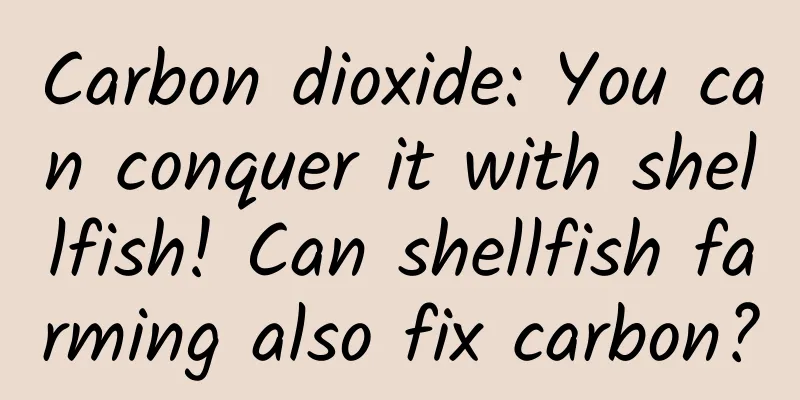Carbon dioxide: You can conquer it with shellfish! Can shellfish farming also fix carbon?

|
Problems such as global warming and extreme weather are closely related to the increase in CO2 content in the atmosphere and have become major environmental issues. In 2022, global greenhouse gas emissions reached 57.4 billion tons of carbon dioxide equivalent, of which CO2 emissions from fossil fuel combustion and industrial processes accounted for about 2/3. Climate change has led to problems such as melting glaciers, rising sea levels and accelerated ocean warming, and extreme weather has had a serious impact on the social economy. Scientists predict that if current emissions continue, the earth's temperature may rise by 3 to 5°C by the end of the 21st century, which will bring unpredictable disasters. Faced with the dual pressures of economic development and environmental protection, China has proposed to achieve "carbon peak" by 2030 and "carbon neutrality" by 2060. Carbon peak refers to the gradual decline of total carbon dioxide emissions after reaching a peak at a certain point in time. It is essentially an issue of energy transformation and ecological protection. Carbon neutrality means that greenhouse gas emissions are equal to or less than the absorption of the natural environment, achieving "net zero emissions". In order to achieve the dual carbon goals, it is necessary to implement a "negative emission" strategy, and carbon sinks have become a key approach. Definition and classification of carbon sinks Carbon sink is the process of removing carbon dioxide from the air, mainly through measures such as afforestation, biological absorption, vegetation restoration, etc., through photosynthesis and other methods to fix carbon dioxide in the ecosystem, reducing the concentration of greenhouse gases in the atmosphere. Carbon sinks are divided into terrestrial carbon sinks and marine carbon sinks. •Terrestrial carbon sinks: including forests, grasslands, cultivated land, soil and wetland carbon sinks. • Marine carbon sink (blue carbon): absorbs greenhouse gases through marine ecosystems. The ocean covers 70.8% of the Earth’s surface area and is one of the largest carbon reservoirs, absorbing about 30% of CO2 in the atmosphere each year, which is much more efficient than terrestrial ecosystems. my country has 3 million square kilometers of marine territory and is the largest marine aquaculture country, mainly shellfish farming, with huge potential for marine "negative emissions". Shellfish farming, especially oysters, clams and scallops, has a high carbon sink conversion rate. It can not only effectively absorb carbon dioxide, but also purify water and regulate CO2 content. It is an important way for my country to achieve its dual carbon goals. Mechanisms of ocean carbon sinks There are two main types of marine carbon sink mechanisms, namely physical carbon fixation and biological carbon fixation. The physical carbon fixation mechanism, also known as the physical pump, is that when the atmospheric CO2 partial pressure is higher than the pCO2 partial pressure of seawater at a certain moment, the CO2 in the atmosphere will directly enter the seawater and then be transported to the deep sea. The hydrodynamics of the carbon sink process mainly depends on natural factors, such as ocean currents, wind, pH, etc. There is little potential to increase carbon flux through artificial means. Marine biological carbon sequestration refers to the carbon pump driven by marine organisms, which mainly transfers organic carbon through the photosynthesis of algae or the food chain of shellfish and fish, and is eventually harvested and utilized by humans or deposited in the deep sea and buried when the organisms die, achieving the carbon storage effect. Marine carbon sinks - Shellfish sequestering carbon Because they do not require artificial breeding during their growth period and can rely on natural resources to sustain their lives, marine farmed shellfish are called promising "green filters for the ocean". Shellfish do not consume any fresh water resources during their growth period, and do not require antibiotics or other drugs that may cause deterioration of the aquaculture water. This is an environmentally friendly fishery activity. Carbon fixation in shellfish Shellfish interact with phytoplankton, fine organic debris and seawater carbonate systems through processes such as filtration, respiration, calcification and biosedimentation, allowing particulate organic carbon (POC) in the water to be effectively utilized and consumed. So where does this biologically fixed carbon go? It may be removed from the seawater carbon cycle (for example, humans harvested a batch of oysters, so carbon was removed), or it may exist in the seawater in the form of particulate organic carbon (POC) and dissolved organic carbon (DOC), as well as carbon deposited on the seafloor, such as shellfish feces and shells sinking to the seafloor. Shellfish carbon fixation, in a broad sense, refers to the carbon fixation by shellfish through the formation of calcium carbonate shells and soft tissues during their growth. Four ways of carbon fixation in shellfish: carbon fixation in shells, carbon fixation in soft bodies, carbon fixation in biological sediments, and carbon fixation in attached organisms Marine carbon sink enhancement technology Based on the current carbon sink capacity of the ocean, researchers are also constantly exploring technologies to increase carbon sinks. Studies have shown that my country's marine fisheries and aquaculture industries are likely to achieve an annual carbon sequestration of 460 million tons, and the realization of this goal is inseparable from the improvement of carbon sink enhancement technologies. In fishery production, shellfish and algae farming and phytoplankton in the euphotic zone are the main forces in carbon storage. According to the law of conservation of carbon, as early as 2002, shellfish and algae farmed in my country's marine waters had fixed more than 3 million tons of carbon, providing new clues to the global carbon sink source. The carbon sequestration capacity of algae is closely related to the species and the on-site environment. The cultivation process will be affected by itself, the environment and human activities. Creating a positive scenario can enhance the carbon sink effect of shellfish and algae, thereby achieving higher ecological benefits. Therefore, shellfish and algae with high carbon sequestration capacity should be cultivated according to local conditions. Pilot studies have found that the carbon sink generated by mixed cultivation of shellfish and algae is much greater than the carbon sink generated by cultivating shellfish or algae alone. Based on this, future marine aquaculture should move closer to a multi-trophic level integrated aquaculture model. In addition, from the perspective of coordinated development of land and sea, for ecosystem environments such as coastal wetlands, carbon sinks can be increased by establishing carbon flux monitoring networks, analyzing ecological dynamic mechanisms, and building demonstration areas. References [1] Yin Yuwen. Research on carbon sink of marine aquaculture shellfish[D]. Dalian Ocean University, 2024. [2] Ji Xuehui. Research on pricing of blue carbon sequestration in marine ranches[D]. Dalian Ocean University, 2024. [3] Song Shasha, Zhao Jianping, Wu Yidan, et al. Discussion on the path of coordinated development of marine carbon sinks and marine energy[J]. Marine Information Technology and Applications, 2023, 38(4):200-205. [3] He Yixiong, Wang Yanwei, Xie Sumei, et al. Research progress of marine carbon sink in my country: literature analysis based on CNKI (2006-2021) [J]. Marine Economy, 2022, 12(04): 1-16. [4] Song Shasha, An Wei, Zhang Qingfan, et al. Mechanism, path and suggestions for carbon sink development in marine ecological restoration [J/OL]. Coastal Engineering, 1-11 [2024-11-14]. [5] Zhang Yongyu, Zhang Jihong, Liang Yantao, et al. Formation process and mechanism of carbon sink in China's offshore aquaculture environment[J]. Science China: Earth Sciences, 2017, 47(12): 1414-1424. [6] Jia Wenjing. Research on economic value accounting of marine carbon sink and its spatial spillover effect[D]. Dalian Ocean University, 2024. DOI: 10.27821/d.cnki.gdlhy.2024.000133. |
<<: How fast is the Earth moving on a cosmic scale?
Recommend
Unveiling the Secrets of DeepGlint: How Do Computers Understand Our World?
[[124218]] Do you find a white A4 paper on the wh...
It can reduce fatigue but is not yet mature. Let's talk about the advantages and disadvantages of adaptive cruise control.
Cruise is divided into fixed speed cruise and ada...
How to design a hit product
Nowadays, we often see hot products from various ...
50 articles on the operation and delivery of Xiaohongshu brand accounts
Although I am writing about how brands should ope...
Electric Technology Car News: Can Jiangxi Isuzu D-MAX continue to be popular with its avant-garde design and reasonable interior design?
Since being introduced into China in 2014, Jiangx...
Toutiao video information flow advertising marketing plan!
Toutiao video information flow advertising market...
A major project that humans delayed for 7 years was repaired by beavers overnight?
They completed a project that had been delayed fo...
The “last mile” of integrated marketing
When we talk about ROI, it is no longer an abbrev...
Seth Klarman is a truly great book
I took a lot of notes while reading this book, es...
The express delivery arrives but I don’t know how to sign for it, what should I do?
[51CTO.com original article] Are you still rushin...
Mobile Internet Channel Promotion Methodology
Friends often ask me that they spent a lot of mon...
Don’t know how to increase your conversion rate? Let’s play games!
There is a very interesting thing recently. There...
Not only beautiful but also fun to use: How much do you know about the black technology of mobile photography?
Since the first generation of iPhone changed the ...
It only takes 5 minutes to teach you how to play Super Fan Pass
On September 21, Weibo launched a new information...
3 concepts to analyze Taobao user incentive system
I have always wanted to write down and summarize ...









